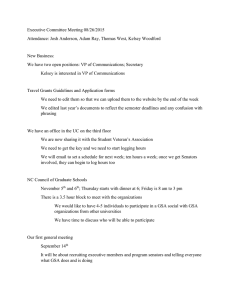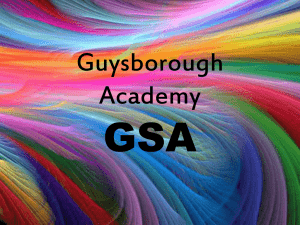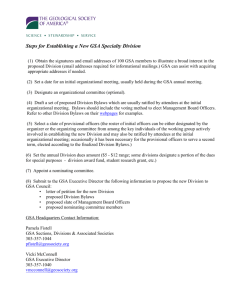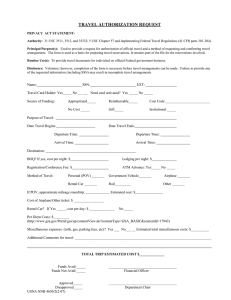Jen Schneider, Colorado School of Mines, Golden, Colorado 80401, USA, Roel Snieder,
advertisement
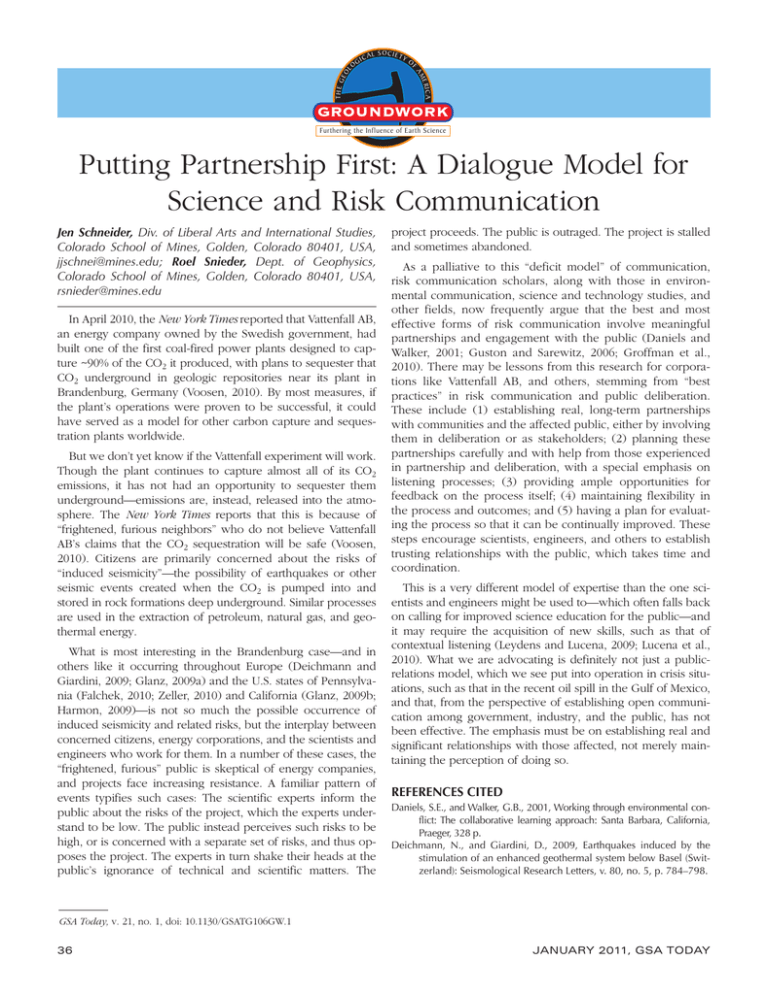
CA L SOCIETY O F AM OL GI ERIC A THE G E O GROUNDWORK Furthering the Influence of Earth Science Putting Partnership First: A Dialogue Model for Science and Risk Communication Jen Schneider, Div. of Liberal Arts and International Studies, Colorado School of Mines, Golden, Colorado 80401, USA, jjschnei@mines.edu; Roel Snieder, Dept. of Geophysics, Colorado School of Mines, Golden, Colorado 80401, USA, rsnieder@mines.edu In April 2010, the New York Times reported that Vattenfall AB, an energy company owned by the Swedish government, had built one of the first coal-fired power plants designed to capture ~90% of the CO2 it produced, with plans to sequester that CO2 underground in geologic repositories near its plant in Brandenburg, Germany (Voosen, 2010). By most measures, if the plant’s operations were proven to be successful, it could have served as a model for other carbon capture and sequestration plants worldwide. But we don’t yet know if the Vattenfall experiment will work. Though the plant continues to capture almost all of its CO2 emissions, it has not had an opportunity to sequester them underground—emissions are, instead, released into the atmosphere. The New York Times reports that this is because of “frightened, furious neighbors” who do not believe Vattenfall AB’s claims that the CO2 sequestration will be safe (Voosen, 2010). Citizens are primarily concerned about the risks of “induced seismicity”—the possibility of earthquakes or other seismic events created when the CO2 is pumped into and stored in rock formations deep underground. Similar processes are used in the extraction of petroleum, natural gas, and geothermal energy. What is most interesting in the Brandenburg case—and in others like it occurring throughout Europe (Deichmann and Giardini, 2009; Glanz, 2009a) and the U.S. states of Pennsylvania (Falchek, 2010; Zeller, 2010) and California (Glanz, 2009b; Harmon, 2009)—is not so much the possible occurrence of induced seismicity and related risks, but the interplay between concerned citizens, energy corporations, and the scientists and engineers who work for them. In a number of these cases, the “frightened, furious” public is skeptical of energy companies, and projects face increasing resistance. A familiar pattern of events typifies such cases: The scientific experts inform the public about the risks of the project, which the experts understand to be low. The public instead perceives such risks to be high, or is concerned with a separate set of risks, and thus opposes the project. The experts in turn shake their heads at the public’s ignorance of technical and scientific matters. The project proceeds. The public is outraged. The project is stalled and sometimes abandoned. As a palliative to this “deficit model” of communication, risk communication scholars, along with those in environmental communication, science and technology studies, and other fields, now frequently argue that the best and most effective forms of risk communication involve meaningful partnerships and engagement with the public (Daniels and Walker, 2001; Guston and Sarewitz, 2006; Groffman et al., 2010). There may be lessons from this research for corporations like Vattenfall AB, and others, stemming from “best practices” in risk communication and public deliberation. These include (1) establishing real, long-term partnerships with communities and the affected public, either by involving them in deliberation or as stakeholders; (2) planning these partnerships carefully and with help from those experienced in partnership and deliberation, with a special emphasis on listening processes; (3) providing ample opportunities for feedback on the process itself; (4) maintaining flexibility in the process and outcomes; and (5) having a plan for evaluating the process so that it can be continually improved. These steps encourage scientists, engineers, and others to establish trusting relationships with the public, which takes time and coordination. This is a very different model of expertise than the one scientists and engineers might be used to—which often falls back on calling for improved science education for the public—and it may require the acquisition of new skills, such as that of contextual listening (Leydens and Lucena, 2009; Lucena et al., 2010). What we are advocating is definitely not just a publicrelations model, which we see put into operation in crisis situations, such as that in the recent oil spill in the Gulf of Mexico, and that, from the perspective of establishing open communication among government, industry, and the public, has not been effective. The emphasis must be on establishing real and significant relationships with those affected, not merely maintaining the perception of doing so. REFERENCES CITED Daniels, S.E., and Walker, G.B., 2001, Working through environmental conflict: The collaborative learning approach: Santa Barbara, California, Praeger, 328 p. Deichmann, N., and Giardini, D., 2009, Earthquakes induced by the stimulation of an enhanced geothermal system below Basel (Switzerland): Seismological Research Letters, v. 80, no. 5, p. 784–798. GSA Today, v. 21, no. 1, doi: 10.1130/GSATG106GW.1 36 JANUARY 2011, GSA TODAY Falchek, D., 2010, Hearing on a landmark study of hydraulic fracturing now postponed, The Times-Tribune (11 Aug. 2010): http://thetimestribune.com/news/hearing-on-a-landmark-study-of-hydraulicfracturing-now-postponed-1.939654 (last accessed 16 Oct. 2010). Glanz, J., 2009a, Deep in bedrock, clean energy and quake fears (23 June 2010): The New York Times: http://www.nytimes.com/2009/06/24/ business/energy-environment/24geotherm.html (last accessed 12 Aug. 2010). Glanz, J., 2009b, Quake fears stall energy extraction project (13 July 2010): The New York Times, http://www.nytimes.com/2009/07/14/business/ energy-environment/14drill.html (last accessed 16 Oct. 2010). Groffman, P.M., Stylinski, C., Nisbet, M., Duarte, C., Jordan, R., Burgin, A., Previtali, M.A., and Coloso, J., 2010, Restarting the conversation: Challenges at the interface between ecology and society: Frontiers in Ecology and the Environment, v. 8, no. 6, p. 284–291. Guston, D.H., and Sarewitz, D., 2006, Shaping science and technology policy: The next generation of research: Madison, Wisconsin, University of Wisconsin Press, 382 p. Harmon, K., 2009, How does geothermal drilling trigger earthquakes? (29 June 2009): Scientific American online: http://www.scientificamerican.com/article.cfm?id=geothermal-drilling-earthquakes (last accessed 16 Oct. 2010). Leydens, J., and Lucena, J.C., 2009, Listening as a missing dimension in engineering education: Implications for sustainable community development efforts: Special issue on professional communication in humanitarian environments: IEEE Transactions on Professional Communication, v. 52, no. 4, p. 359–376. Lucena, J., Schneider, J., and Leydens, J.A., 2010, Engineering and sustainable community development: San Rafael, California, Morgan & Claypool, 230 p., doi: 10.2200/S00247ED1V01Y201001ETS011. Voosen, P., 2010, Frightened, furious neighbors undermine German CO2trapping power project (7 Apr. 2010): The New York Times, http://www.nytimes.com/gwire/2010/04/07/07greenwire-frightenedfurious-neighbors-undermine-german-35436.html (last accessed 12 Aug. 2010). Zeller, T., Jr., 2010, E.P.A. Considers Risks of Gas Extraction (23 July 2010): The New York Times: http://www.nytimes.com/2010/07/24/business/ energy-environment/24gas.html (last accessed 12 Aug. 2010). Manuscript received 16 Sept. 2010; accepted 22 Oct. 2010. Groundwork articles combine geoscience commentary, analysis of hot topics, and discussion of policy news & issues with the goal of furthering the influence of earth science worldwide. Your GSA Today contribution will reach over 23,000 readers. Submission guidelines are online at www.geosocity.org/pubs/gsatguid.htm. 2011 GSA Student Research Grants Students must be GSA Members to apply and may only receive a grant once at the master’s level and once at the Ph.D. level. Those who have applied for grant funding but have not received a grant are welcome to apply again. The maximum award per grant is US$4,000. The GSA student research grant application process is available online only; no paper applications or letters will be accepted. Apply online at www .geosociety.org/grants/gradgrants.htm. Online submission must be completed by Tues., 1 February 2011, at 11:59 p.m. MST. For further information on the 2011 Research Grants Program, go to www.geosociety.org/grants/ gradgrants.htm, call +1-303-357-1028, or e-mail awards@geosociety.org. GSA TODAY, JANUARY 2011 37
